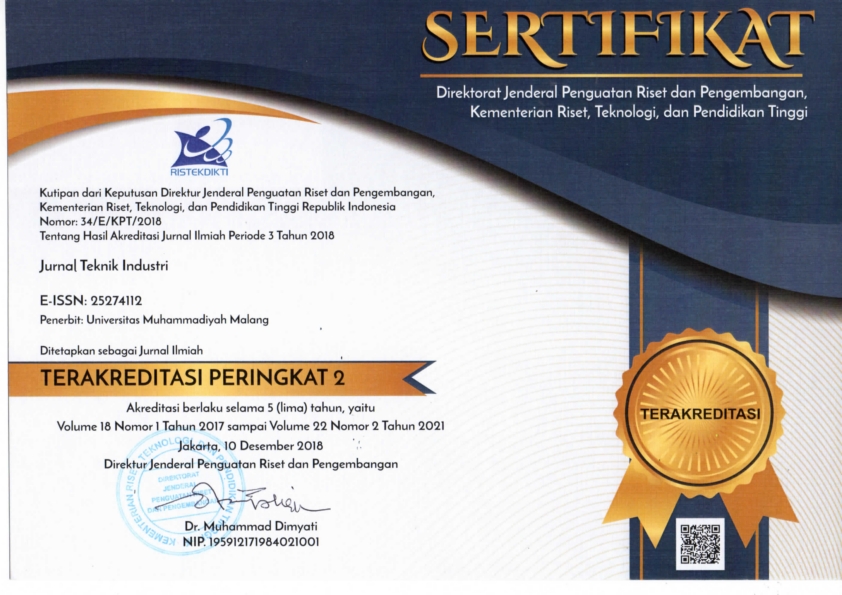Penerapan Lean Sigma untuk Menggurangi Waste pada Produksi Benih Jagung
DOI:
https://doi.org/10.22219/JTIUMM.Vol8.No1.88-98Keywords:
lean-six sigma, VALSAT, FMEAAbstract
Corn seed is one of the product types of PT Bisi where they have. At this time, the industries indicated to conduct waste to their production process. the problem clearly can be seen to the less controlling the germinator machine, drying process up not work as over time waiting and over production so the pilled product up at warehouse. From that problems cause the industry realizes loss of financial and the time aspect. The mainly objective this research was to decrease the incjjIciency effect in subtracting the waste happened. Then, the using Lean-Six Sigma concept is integration between Lean concept and focus which eliminate the waste and slightly process have not needed by emphasize to speed process and Six-Sigma concept that focus to push variance process on to acquire the passing level zero defect (0%) in getting satisfaction costumers. the steps of this research are dcfIne identification the problems, measure determines problems that influence used VALSAT to select appropriate tools to find critical quality of waste and analyze contains /Ish bone diagram help to find primary problems that cause the waste and improve is Failure Mode and Effect Analysis (FMEA) to aid determining the alternative suggestion will be given. From the define step, measure and analyze had known that waste happened in the industry was excess processing, waiting and over production so that it appeared repairing suggestion that was given on improve step which checked to germinator machine, controlled suitable drying time in minimize the waiting and gave actual information toward change market order to limit over production. With decrease the waste would be hoped to create effectively corn seed production process with performance better and slightly.
Downloads
References
Agus K., 2005. Analisis Penerapan Metode Six Sigma pada Proses Produksi di PT. Agronesia, Bandung: Jurusan Teknik Industri, Universitas Widyatama.
Anggraini, M., 2006. Analisa dan Evaluasi Risiko Supply Chain di Lamp Component Factory PT Philips Lighting Surabaya. Surabaya: Tugas Akhir JurusanTeknik Industri, Institut Teknologi Sepuluh November.
Dewi FA., 2006. Aplikasi Pendekatan Business Process Modelling dalam Proses Perencanaan Produksi (Studi Kasus: PT IGLAS, Persero). Surabaya: Tugas Akhir Jurusan Teknik Industri, Institut Teknologi Sepuluh Nopember.
Gaspersz, V., 2002. Pedoman Implementasi Program Six Sigma Terintegrasi Dengan ISO 9001:2000, MBNQA, dan HACCP. Jakarta: pT Gramedia pustaka Utama, Jakarta.
Gaspersz, V., 2006. Lean Six Sigma for Manufacturing and Srevice Industries. Jakarta: pT Gramedia pustaka Utama, Jakarta.
Gaspersz, V., 2007. Continuous Cost Reduction Though Approach Lean-Sigma. Jakarta: pT Gramedia pustaka Utama, Jakarta.
Gaspersz, V., Lean-Sigma Green Company. , diakses tanggal 30 januari 2008.
hastuti, IA., 2006. Evaluasi dan Perbaikan Proses Produksi dengan Pendekatan Lean Six Sigma (Studi Kasus: PT Pura Barutama Unit Konverta).
Surabaya: Tugas Akhir Jurusan Teknik Industri, Institut Teknologi Sepuluh Nopember.
Kristina: Penerapan Lean Sigma untuk Produksi Benih Jagung
Hines, peter and Rich, Nick (1997). The Seven Value Stream Mapping Tools. Lean Enterprises Research Center, Cardiff Business School, Cardiff, UK. International Journal Of Operation And production Management. Vol. 1, No. 1, pp. 46-04.
Intannia, CD., (2005). "Analisa Klaim Konsumen Telkomnet@Instan dengan Pendekatan Failure Mode and Effect Analysis (FMEA) (Studi Kasus: PT TELKOM DIVRE V JATIM)". Surabaya: Tugas Akhir Jurusan Teknik Industri, Institut Teknologi Sepuluh Nopember.
Iwan, V., Aplikasi Pemetaan Aliran Nilai di Industri Kemasan Semen. Dosen Fakultas Teknologi Industri, Jurusan Teknik Industri. Surabaya.











